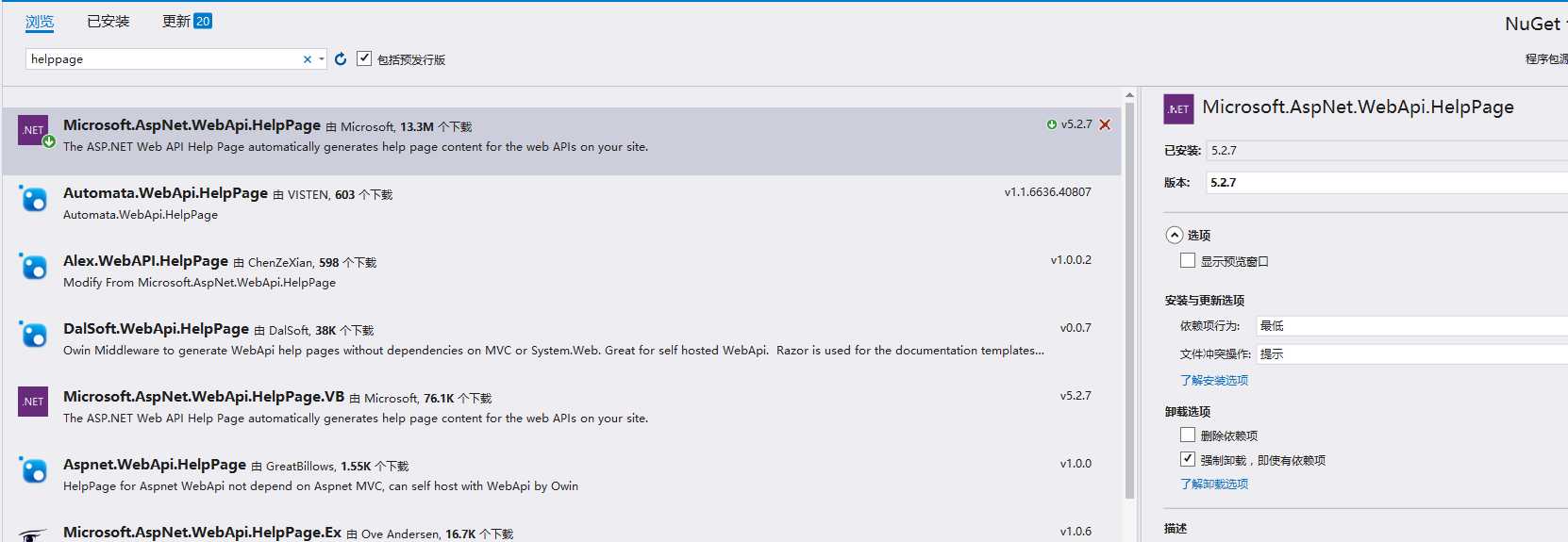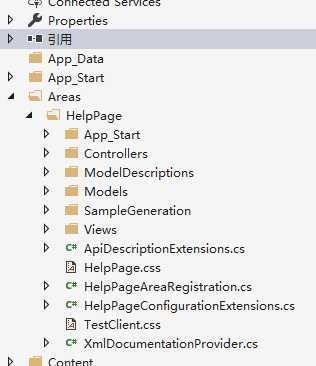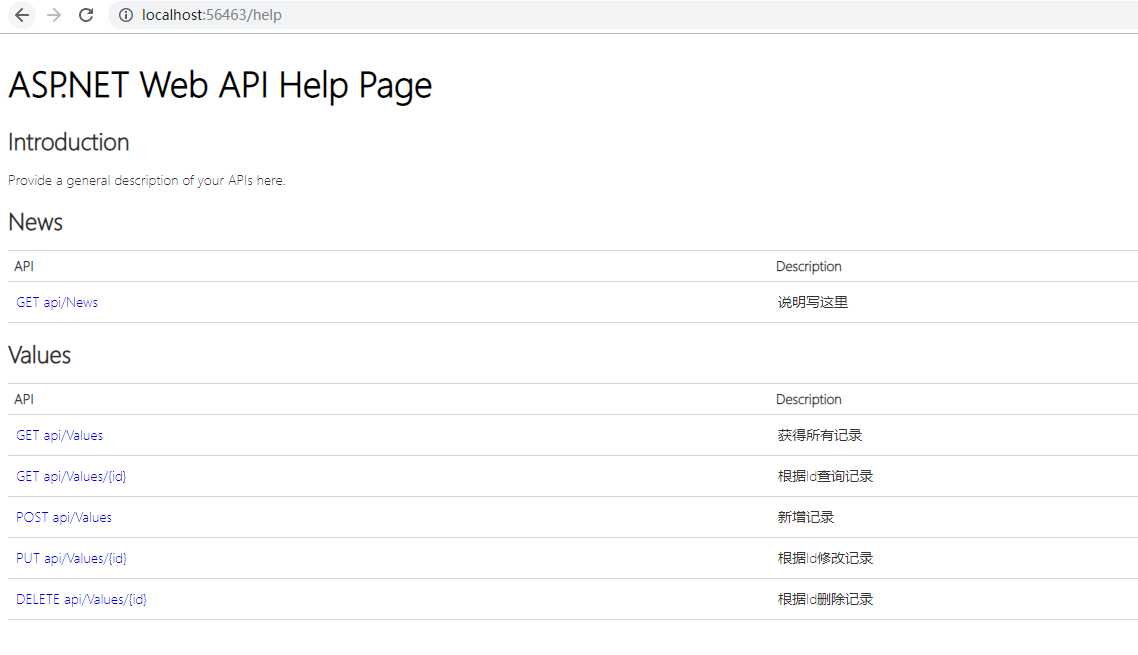WebAPI HelpPage帮助页
2021-01-29 13:12
标签:文件中 names end local org xml文件 dia 注意 web WebAPI HelpPage是个插件,根据代码的注释生成API说明页,一目了然。 下面开始安装和配置 先选择管理NuGet程序包,搜索 Microsoft.AspNet.WebApi.HelpPage 然后当然是安装啦~~~ 安装完成后我们看项目下是不是多出了一个文件夹Areas ,就是它 到了这步,我们先了解下App_Start 下的 HelpPageConfig.cs ,打开后一堆注释,一个Register方法,它用来注册HelpPage页面需要展示的API的文档的。 默认支持单文档导入,我们建立一个支持多文件注册类 然后修改HelpPageConfig.cs文件中的代码,注意XML地址: "~/bin/APIDemo.xml"这个文件需要我们在属性下设置的,让其生成相关xml文件 右击项目=》属性=》生成=》勾选XML文档文件,填写地址,把上面的地址填进去。 进入到Global.asax的Application_Start方法看看有没有注册上Area 然后就可以建立控制器测试下好了没,下面是我的控制器 运行: 其实看Areas文件夹下的控制器文件夹,有一个HelpController的控制器,生成了几个 Action 我们可以看到Index, 访问它就可以呈现下面的页面了。 到这里就成功了,API列下有访问的地址,Description列下面是说明。 WebAPI HelpPage帮助页 标签:文件中 names end local org xml文件 dia 注意 web 原文地址:https://www.cnblogs.com/zousc/p/11858882.html1.添加引用


2.添加扩展
using APIDemo.Areas.HelpPage.ModelDescriptions;
using System;
using System.Collections.Generic;
using System.Linq;
using System.Reflection;
using System.Web;
using System.Web.Http.Controllers;
using System.Web.Http.Description;
namespace APIDemo.Areas.HelpPage.App_Start
{
public class MultiXmlDocumentationProvider : IDocumentationProvider, IModelDocumentationProvider
{
private readonly XmlDocumentationProvider[] Providers;
public MultiXmlDocumentationProvider(params string[] paths)
{
this.Providers = paths.Select(p => new XmlDocumentationProvider(p)).ToArray();
}
public string GetDocumentation(MemberInfo subject)
{
return this.GetFirstMatch(p => p.GetDocumentation(subject));
}
public string GetDocumentation(Type subject)
{
return this.GetFirstMatch(p => p.GetDocumentation(subject));
}
public string GetDocumentation(HttpControllerDescriptor subject)
{
return this.GetFirstMatch(p => p.GetDocumentation(subject));
}
public string GetDocumentation(HttpActionDescriptor subject)
{
return this.GetFirstMatch(p => p.GetDocumentation(subject));
}
public string GetDocumentation(HttpParameterDescriptor subject)
{
return this.GetFirstMatch(p => p.GetDocumentation(subject));
}
public string GetResponseDocumentation(HttpActionDescriptor subject)
{
return this.GetFirstMatch(p => p.GetDocumentation(subject));
}
private string GetFirstMatch(Func
namespace APIDemo.Areas.HelpPage
{
public static class HelpPageConfig
{
[SuppressMessage("Microsoft.Globalization", "CA1303:Do not pass literals as localized parameters",
MessageId = "APIDemo.Areas.HelpPage.TextSample.#ctor(System.String)",
Justification = "End users may choose to merge this string with existing localized resources.")]
[SuppressMessage("Microsoft.Naming", "CA2204:Literals should be spelled correctly",
MessageId = "bsonspec",
Justification = "Part of a URI.")]
public static void Register(HttpConfiguration config)
{
//config.SetSampleForMediaType(
// new TextSample("Binary JSON content. See http://bsonspec.org for details."),
// new MediaTypeHeaderValue("application/bson"));
config.SetDocumentationProvider(new MultiXmlDocumentationProvider(
HttpContext.Current.Server.MapPath("~/bin/APIDemo.xml")));
}
}
}
3.XML文档文件设置
4.注册
protected void Application_Start()
{
AreaRegistration.RegisterAllAreas();
GlobalConfiguration.Configure(WebApiConfig.Register);
FilterConfig.RegisterGlobalFilters(GlobalFilters.Filters);
RouteConfig.RegisterRoutes(RouteTable.Routes);
BundleConfig.RegisterBundles(BundleTable.Bundles);
}

public class NewsController : ApiController
{
///
public ActionResult Index()
{
ViewBag.DocumentationProvider = Configuration.Services.GetDocumentationProvider();
return View(Configuration.Services.GetApiExplorer().ApiDescriptions);
}
public ActionResult Api(string apiId)
{
if (!String.IsNullOrEmpty(apiId))
{
HelpPageApiModel apiModel = Configuration.GetHelpPageApiModel(apiId);
if (apiModel != null)
{
return View(apiModel);
}
}
return View(ErrorViewName);
}
public ActionResult ResourceModel(string modelName)
{
if (!String.IsNullOrEmpty(modelName))
{
ModelDescriptionGenerator modelDescriptionGenerator = Configuration.GetModelDescriptionGenerator();
ModelDescription modelDescription;
if (modelDescriptionGenerator.GeneratedModels.TryGetValue(modelName, out modelDescription))
{
return View(modelDescription);
}
}
return View(ErrorViewName);
}

